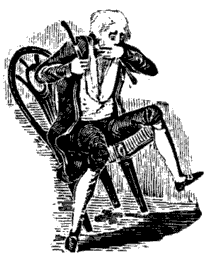

|
|
|
'The Distresses of a Modest Man' was published in The Hive
of Ancient and Modern Literature, (Solomon Hodgson, Newcastle,
1799).
This amusing eighteenth-century tale recounts the catalogue
of disasters and misfortunes that befall a 'modest man' when
he takes up an invitation to dine with his neighbour, Sir Thomas
Friendly. You will have to read the story to find out how Xenophon
is involved.
I first came across the story twenty years ago while working
on my Luke Clennell: Bewick Apprentice in the Bewick Collection
of Newcastle upon Tyne's City Library. It has been my intention
ever since to publish The Fall of Xenophon and I am
now pleased to offer this entertaining adventure to a wider
audience. The illustrations are adaptations and enlargements
of four contemporary wood engravings. 'The dinner' shown here
was engraved by Thomas Bewick for the Hive.
Printed on a Wharfedale Press on Zerkall mould made paper in
a limited edition of 300 copies. Hand sewn and bound in paste-paper
boards.
Publication: 2000. 16 pp 250mm x 164mm £60 ($95)
The digitally mastered handmade
book
The original text was scanned and converted into a Word file
where it was 'cleaned' before importing into a Quark Xpress
document in which I defined the page design and layout. The
file was then output to negative film at a resolution of 2400
dpi. I used the negatives to make photopolymer plates. These
were printed letterpress on a hand-fed Wharfedale cylinder press.
The illustrations
I set out with the intention of illustrating the story with
my own drawings and made a number of preliminary sketches. I
soon realized the contemporary wood engravings portrayed the
mood, dress, and setting of the tale so well that it would be
difficult to do better. Therefore, with the aid of modern technology
I scanned, then enlarged and adapted the wood engravings using
Photoshop. I hope you share my admiration for the detail which
is revealed in these lively images. The virtuosity and draughtsmanship
of these miniatures is all the more amazing considering they
were engraved on wood blocks measuring no more than two by three
inches. |